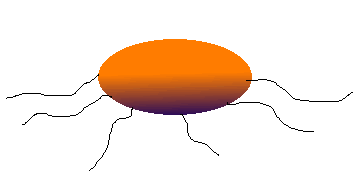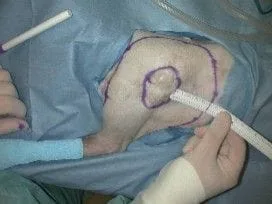Key Points
Soft tissue sarcoma is a type of cancer that frequently has a lower rate of spread other parts of the body
Because these tumors usually have deep roots, aggressive surgery is needed to successfully remove the tumor
Prognosis is dependant on the grade of the tumor, degree of invasion, location on the body and the ability of the surgeon to remove a cuff of normal tissue along with the tumor
Definition
- A soft tissue sarcoma is broad group of tumors that originate from connective tissues
Types of Soft tissue sarcomas
- Fibrosarcoma – originates from fibrocytes or connective tissues
- Neurofibrosarcoma – originates from the connective tissue around nerves
- Anaplastic sarcoma – are very malignant sarcoma cells
- Many other types
Behavior
- Generally soft tissue sarcomas are very locally invasive; this means that they have deep roots extending off of the apparent tumor mass

- The potential for a soft tissue sarcoma to spread to another location in the body is dependant on its grade as diagnosed on the biopsy report
- grade I – 5 to 10% chance for spread to other regions in the body
- grade II – 25% chance for spread
- grade III – 50% chance for spread
Location
- Skin
- Under the skin
- Muscles
- Mouth
- Below is a fibrosarcoma on the shoulder region – in this case wide surgical margins will be taken

- Below is a high grade soft tissue sarcoma located beneath the tongue and affecting the jaw

Diagnostic testing
- Complete blood cell count, chemistry profile, urinalysis
- Chest radiographs
- Biopsy of the tumor
- Below is an example of cells as seen under a microscope from a soft tissue sarcoma; a fine needle biopsy can be used to obtain such a sample

Surgery
- Wide surgical margins are needed to cure a soft tissue sarcoma
- wide lateral margins – typically we remove 2 to 5 cm of normal tissue around the mass
- deep margins – typically we remove a layer of dense tissue beneath the tumor, such as fascia or muscle
- after the tumor has been removed, the cut side of the tissue is painted with ink so that the pathologist see if the entire tumor had been removed
- Wound closure – in some cases the resultant wound can be closed primarily, but in other cases a skin flap or skin graft is needed to close the wound
Treatments after surgery
- For grade I soft tissue sarcomas generally no additional treatment is needed if the tumor has been completely removed
- For grade 2 and 3 soft tissue sarcomas generally chemotherapy is recommended
- Radiation therapy is indicated for tumors in which there is a high risk for recurrence of the tumor
Prognosis
- Radical surgical treatment can result in cure of a soft tissue sarcoma providing that the tumor is completely removed
- Soft tissue sarcomas that have spread carry a poor prognosis


